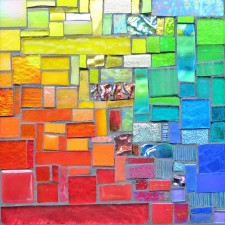Marie Curie is probably the one scientist people can name who was a woman. She spent years her life searching for an element that showed few signs of existing, boiling bags of pitchblende in a huge crucible, with an iron rod taller than she was. She discovered radium, and she and her husband Pierre received a Nobel Prize for this in 1903. In 1906, Pierre was killed by a horse and carriage as he crossed the street. I became intrigued by her story several years ago, and wrote a series of poems about her life, and even then, before I became a visual artist, I was drawn to the visual sense, the glow and sparkle of radium in the dark.
***
I shall not kill myself, but among all these
vehicles is there not one to make me share
the fate of my beloved? I work my days
in the laboratory. I am better off there
than anywhere else. She won another
Nobel Prize, amidst grumbling that the first
was through simple brute effort, that Pierre
had done all the work. These words like alkahest—
alchemy’s universal solvent. She did not kill
herself, did not dissolve, testing the chemicals
of her grief. Pierre had hoped radium was a beautiful
color. Radium preserved as a chloride is as dull
as common kitchen salt. But this is in light—
in dark it sparkles. God also created night.
–Margaret Almon
***
At the beginning of WWI, in 1914, when Germany attacked France, Curie realized that the ability to take X-Rays would make treating shrapnel and other injuries on the front much easier. With the same intense energy and passion she used to discover radium, she endeavored to raise money for radiology equipment and convinced manufacturers to turn cars into vans, and created 20 of what the French soldiers called “petite Curies“–mobile X-Ray vehicles which went to the front. This was an incredible feat, since most hospitals didn’t even have X-Ray departments at this point. Curie taught herself to drive, crammed anatomy books, and took her 17 year old daughter Irene as an assistant, along with a military doctor, and went to the front herself, all without Pierre, whom she missed immensely.
***
The material and personnel were multiplied
as if by enchantment. Marie’s WWI creation, “little Curies,”
radiological cars driven to the front, darkness intensified
by the bright bones. X-Ray machinery run by car motors,
in the hearse-like backseat, powering the journey beneath the skin.
She trained girls in techniques. Irene at seventeen
located shrapnel in a man’s thigh—the surgeon, he
did not believe her eyes, or elementary geometry.
Over a million men passed through, shattered multitude.
No fear. No protection from radiation—
We cannot say that word, weighing like a lead apron.
In this practical miracle, Marie saw it was good.
The unsuspected amplitude that the application of pure
scientific discoveries can take during war.
–Margaret Almon
***


Xcellent choice for X is for …
Thank you for shares her story and your beautiful poems.
I love that the soldiers called the x-ray vans “little Curies”
Such a wonderful post Margaret. Thanks for sharing information about her that I didn’t know as well as your poems.
Very interesting. Thanks for sharing all that about Madame Curie.
Thank you all for the kind words! I’d forgotten how amazed I was by Marie Curie.